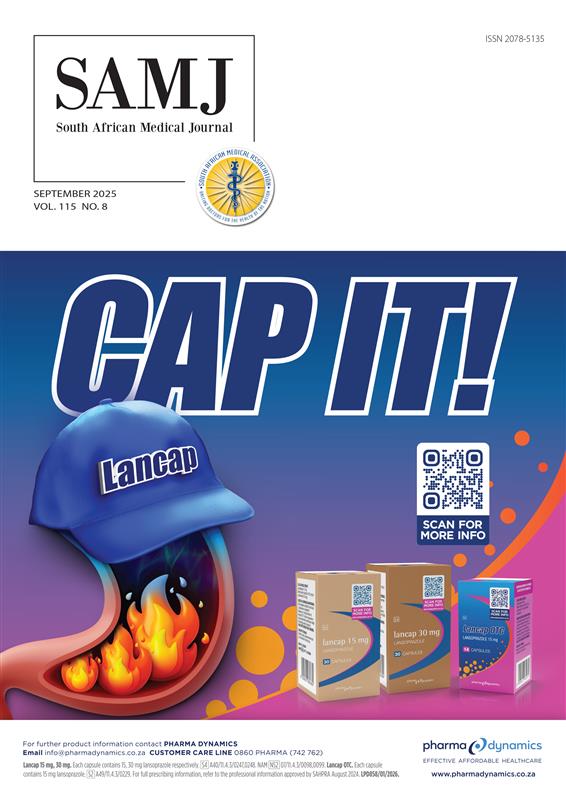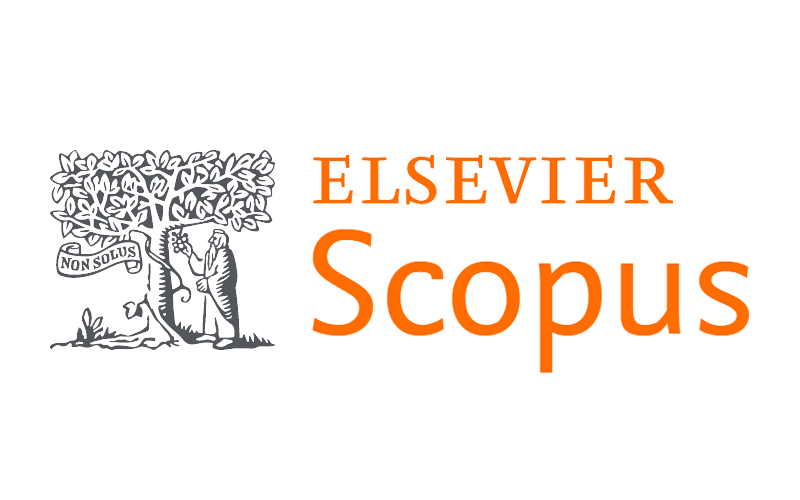Clot twist – D-dimer analysis of healthy adults receiving heterologous or homologous booster COVID-19 vaccine after a single prime dose of Ad26.COV2.S in a phase II randomised open-label trial, BaSiS
DOI:
https://doi.org/10.7196/SAMJ.2025.v115i8.3121Keywords:
Covid-19 vaccine, thrombosis , d-dimer , HIV, coagulopathyAbstract
Background. Rapid COVID‐19 vaccine development occurred during the pandemic and vaccine‐related complications such as thrombosis with thrombocytopenia syndrome were discovered. Clinical trials and treating facilities included D‐dimer testing in COVID‐19 vaccine trials and COVID‐19 disease‐severity assessments, respectively. D‐dimer testing and result interpretation is complex and its use in isolation is controversial.
Objectives. To evaluate D‐dimer levels in healthy adult participants regardless of HIV status, prior to and 2 weeks after receipt of fractional and full‐dose Ad26.COV2.S or Comirnaty booster COVID‐19 vaccination, after a full dose Ad26.COV2.S prime, stratified by booster vaccination arm, age and HIV status.
Methods. BaSiS, a prospective open‐label trial, enrolled 289 healthy adults. Participants with controlled comorbidities, HIV infection with no immunological or virological exclusions, and no prior thrombosis enrolled at four sites in South Africa (SA). Participants previously received a single Ad26.COV2.S prime vaccination through the Sisonke phase IIIB open‐label implementation study or the COVID‐19 vaccine programme in SA. Participants were randomised 1:1:1:1 to receive one of four boosters: full‐dose Ad26.COV2.S, half‐dose Ad26.COV2.S, full‐dose Comirnaty or half‐dose Comirnaty. D‐dimer testing (INNOVANCE D‐dimer assay), as a coagulopathy marker, was conducted before the booster (baseline) and 2 weeks after the booster. The primary objectives previously reported included safety and immunogenicity of booster vaccination and fractional dosing with Ad26.COV2.S or Comirnaty in Ad26.COV2.S‐vaccinated participants. An exploratory objective evaluating clotting profiles, measured by D‐dimers, is reported here.
Results. The median age among 285 evaluable participants included in this analysis was 42.2 (interquartile range (IQR): 35.5 ‐ 48.7) years; 82.5% (235/285) were female and 94.4% (269/285) were black African. Of the 40.4% (115/285) of people living with HIV, 79.1% (91/115) were well controlled on antiretroviral therapy. At baseline, 39.3% (112/285) of participants had elevated D‐dimer levels ‒ all asymptomatic. Females and obese participants were significantly more likely to have elevated baseline D‐dimer levels (adjusted odds ratio (aOR): 3.14, 95% confidence interval (CI): 1.32 ‐ 7.48 and aOR: 2.20, 95% CI: 1.22 ‐ 3.96, respectively). Of 276 participants with D‐dimer results available at 2 weeks after the booster, 109 (39.5%) had elevated D‐dimer levels. Those with elevated levels at baseline and female participants (aOR: 14.75, 95% CI: 7.64 ‐ 28.48 and aOR: 3.24, 95% CI: 1.14 ‐ 9.22, respectively) were significantly more likely to have elevated D‐dimer levels at 2 weeks.
Conclusion. Elevated D‐dimer levels in asymptomatic, low‐risk adults were unexpectedly common and not associated with thromboembolism. This supports the rationale of including D‐dimer testing in conjunction with other coagulopathy markers, only if clinically indicated in both COVID‐19 vaccine clinical trials and the general population.
References
1. World Health Organization. COVID‐19 Weekly Epidemiological Update. 2023. Geneva: WHO, 2023. https://www.who.int/publications/m/item/COVID‐19‐epidemiological‐update (accessed 10 February 2025).
2. Iversen K, Bundgaard H, Hasselbalch RB, et al. Risk of COVID‐19 in health‐care workers in Denmark: An observational cohort study. Lancet Infect Dis 2020;20(12):1401‐1408. https://doi.org/10.1016/S1473‐ 3099(20)30589‐2
3. Liu K, Chen Y, Lin R, Han K. Clinical features of COVID‐19 in elderly patients: A comparison with young and middle‐aged patients. J Infect 2020;80(6):e14‐e18. https://doi.org/10.1016/j.jinf.2020.03.005
4. Sharif N, Ahmed SN, Opu RR, et al. Prevalence and impact of diabetes and cardiovascular disease on
clinical outcome among patients with COVID‐19 in Bangladesh. Diabetes Metab Syndr 2021;15(3):1009‐
1016. https://doi.org/10.1016/j.dsx.2021.05.005
5. Centers for Disease Control and Prevention. Underlying Medical Conditions Associated with Higher
Risk for Severe COVID‐19: Information for Healthcare Professionals. Atlanta: CDC, 2021. https://www.
cdc.gov/covid/hcp/clinical‐care/underlying‐conditions.html (accessed 10 February 2025).
6. Kashte S, Gulbake A, El‐Amin SF, Gupta A. COVID‐19 vaccines: Rapid development, implications, challenges and future prospects. Hum Cell 2021;34(3):711. https://doi.org/10.1007/s13577‐021‐00512‐4
7. Schönborn L, Pavord S, Chen VMY, et al. Thrombosis with thrombocytopenia syndrome (TTS) and vaccine‐induced immune thrombocytopenia and thrombosis (VITT): Brighton Collaboration case definitions and guidelines for data collection, analysis, and presentation of immunisation safety data
(2.0). Vaccine 2024;42(7):1799‐1811. https://doi.org/10.1016/j.vaccine.2024.01.045
8. US Food and Drug Administration. Janssen COVID‐19 Vaccine EUA 27205, USA Department of Health
and Human Services, 2021. https://www.fda.gov/media/150139/download (accessed 4 August 2025).
9. Jacobson BF, Schapkaitz E, Takalani A, et al. Vascular thrombosis after single dose Ad26.COV2.S vaccine in healthcare workers in South Africa: Open label, single arm, phase 3B study (Sisonke study). BMJ Med
2023;2(1):e000302. https://doi.org/10.1136/bmjmed‐2022‐000302
10. Collie S, Champion J, Moultrie H, Bekker LG, Gray G. Effectiveness of BNT162b2 vaccine against
Omicron variant in South Africa. New Engl J Med 2022;386(5):494‐496. https://doi.org/10.1056/
NEJMc2119270
11. European Medicines Agency. Jcovden (COVID‐19 vaccine (Ad26.COV2‐S [recombinant])), Amsterdam, 2023. https://www.ema.europa.eu/en/documents/overview/jcovden‐previously‐COVID‐19‐vaccine‐ janssen‐epar‐medicine‐overview_en.pdf (accessed 10 February 2025).
12. Hamlyn E, Fidler S, Stöhr W, et al. Interleukin‐6 and D‐dimer levels at seroconversion as predictors of HIV‐1 disease progression. AIDS 2014;28(6):869‐874. https://doi.org/10.1097/QAD.0000000000000155
13. Johnson ED, Schell JC, Rodgers GM. The D‐dimer assay. Am J Hematol 2019;94(7):833‐839. https://doi.
org/10.1002/ajh.25482
14. SAHPRA media statement. Safety of the COVID‐19 vaccine: Janssen‐response to restrictions imposed in the United States embargo. Johannesburg: SAHPRA, 2021. https://aefi‐reporting.sahpra.org.za/index. html (accessed 4 August 2024).
15. Zhan H, Chen H, Liu C, et al. Diagnostic value of D‐dimer in COVID‐19: A meta‐analysis and meta‐ regression. Clin Appl Thrombosis/Hemostasis 2021;27. https://doi.org/10.1177/10760296211010976
16. Candeloro M, di Nisio M, Valeriani E, et al. Effects of body composition on the procoagulant imbalance in
obese patients. J Thromb Thrombol 2021;51(4):1036‐1042. https://doi.org/10.1007/s11239‐020‐02287‐1
17. Riou C, Bhiman JN, Ganga Y, et al. Safety and immunogenicity of booster vaccination and fractional dosing with Ad26.COV2.S or BNT162b2 in Ad26.COV2.S‐vaccinated participants. PLoS Global Public
Health 2024;4(4):e0002703. https://doi.org/10.1371/journal.pgph.0002703
18. Bekker LG, Garrett N, Goga A, et al. Effectiveness of the Ad26.COV2.S vaccine in health‐care workers in
South Africa (the Sisonke study): Results from a single‐arm, open‐label, phase 3B, implementation study.
Lancet 2022;399(10330):1141‐1153. https://doi.org/10.1016/S0140‐6736(22)00007‐1
19. Siemens Health Care INNOVANCE D‐Dimer Assay. South Africa: Siemens Health Care. https:// www.siemens‐healthineers.com/en‐za/hemostasis/innovance‐assays/innovance‐d‐dimer (accessed
10 February 2025).
20. Arai N, Collins A. Overview of Innovance D‐dimer of new D‐dimer reagent. Sysmex J Int 2008;18(1):15‐22.
21. American College of Emergency Physicians Clinical Policies Subcommittee (Writing Committee) on
Thromboembolic Disease: Wolf SJ, Hahn SA, Nentwich LM, Raja AS, Silvers SM, Brown MD. Clinical Policy: Critical issues in the evaluation and management of adult patients presenting to the emergency department with suspected acute venous thromboembolic disease. Ann Emerg Med 2018;71(5):e59‐e109. https://doi.org/10.1016/j.annemergmed.2018.03.006
22. Harris PA, Taylor R, Thielke R, Payne J, Gonzalez N, Conde JG. Research electronic data capture (REDCap) ‒ a metadata‐driven methodology and workflow process for providing translational research informatics support. J Biomed Inform 2009;42(2):377‐381. https://doi.org/10.1016/j.jbi.2008.08.010
23. Vassallo A, Shajahan S, Harris K, et al. Sex and gender in COVID‐19 vaccine research: Substantial evidence gaps remain. Front Glob Womens Health 2021;2:83. https://doi.org/10.3389/fgwh.2021.761511
24. South African National Department of Health. Strategy for the Prevention and Management of Obesity in South Africa 2023 ‐ 2028. Pretoria: NDoH, 2023. https://www.health.gov.za/wp‐ontent/uploads/2023/05/
Obesity‐Strategy‐2023‐2028_Final_Approved.pdf (accessed 10 February 2025).
25. Eichinger S, Hron G, Bialonczyk C, et al. Overweight, obesity, and the risk of recurrent venous thromboembolism. Arch Intern Med 2008;168(15):1678‐1683. https://doi.org/10.1001/archinte.168.15.1678
26. Thachil J. Dilemmas in management of suspected venous thromboembolism in the obese patient. Int J
Med 2017;110(8):477‐479. https://doi.org/10.1093/qjmed/hcw143
27. Kuller LH, Tracy R, Belloso W, et al. Inflammatory and coagulation biomarkers and mortality in patients with HIV infection. PLoS Med 2008;5(10):e203. https://doi.org/10.1371/journal. pmed.0050203
28. Favresse J, Lippi G, Roy PM, et al. D‐dimer: Preanalytical, analytical, postanalytical variables, and clinical applications. Crit Rev Clin Lab Sci 2019;55(8):548‐577. https://doi. org/101080/1040836320181529734
29. Adam SS, Key NS, Greenberg CS. D‐dimer antigen: Current concepts and future prospects. Blood 2009;113(13):2878‐2887. https://doi.org/ 10.1182/blood‐2008‐06‐165845.
30. Reagh JJ, Zheng H, Stolz U, et al. Sex‐related differences in D‐dimer levels for venous thromboembolism screening. Acad Emerg Med 2021;28(8):873‐881. https://doi.org/10.1111/ acem.14220
31. Teasdale CA, Hernandez C, Zerbe A, Chege D, Hawken M, El‐Sadr WM. Changes in D‐dimer after initiation of antiretroviral therapy in adults living with HIV in Kenya. BMC Infect Dis 2020;20(1):508. https://doi.org/10.1186/s12879‐020‐05213‐1.
32. Calmy A, Gayet‐Ageron A, Montecucco F, et al. HIV increases markers of cardiovascular risk: Results from a randomised, treatment interruption trial. AIDS 2009;23(8):929‐939. https://doi. org/10.1097/qad.0b013e32832995fa
33. Ledwaba L, Tavel JA, Khabo P, et al. Pre‐ART levels of inflammation and coagulation markers are strong predictors of death in a South African cohort with advanced HIV disease. PLoS ONE 2012;7(3):e24243. https://doi.org/10.1371/journal.pone.0024243
34. Baker J V, Neuhaus J, Duprez D, et al. Changes in inflammatory and coagulation biomarkers: A randomised comparison of immediate versus deferred antiretroviral therapy in patients with HIV infection. J Acquir Immune Defic Syndr 2011;56(1):36‐43. https://doi.org/10.1097/ QAI.0b013e3181f7f61a
35. Borges ÁH, O’Connor JL, Phillips AN, et al. Factors associated with D‐dimer levels in HIV‐infected individuals. PLoS ONE 2014;9(3):e90978. https://doi.org/10.1371/journal.pone.0090978
36. Wada NI, Jacobson LP, Margolick JB, et al. The effect of HAART‐induced HIV suppression on circulating markers of inflammation and immune activation. AIDS 2015;29(4):463‐471. https://doi. org/10.1097/QAD.0000000000000545
37. Shivakoti R, Yang WT, Berendes S, et al. Persistently elevated C‐reactive protein level in the first year of antiretroviral therapy, despite virologic suppression, is associated with HIV disease progression in resource‐constrained settings. J Infect Dis 2016;213(7):1074‐1078. https://doi.org/10.1093/infdis/ jiv573
38. UNAIDS Country Factsheet South Africa 2023. Geneva: UNAIDS, 2023. https://www.unaids.org/ en/regionscountries/countries/southafrica (accessed 10 February 2025).
39. Paliogiannis P, Mangoni AA, Dettori P, Nasrallah GK, Pintus G, Zinellu A. D‐dimer concentrations and COVID‐19 severity: A systematic review and meta‐analysis. Front Public Health 20204;8:432. https://doi.org/10.3389/fpubh.2020
40. Coskun F, Yilmaz D, Ursavas A, Uzaslan E, Ege E. Relationship between disease severity and D‐dimer levels measured with two different methods in pulmonary embolism patients. Multidiscip Respir Med 2010;5(3):168‐172. https://doi.org/10.1186/2049‐6958‐5‐3‐168
41. Ivanko I, Ćelap I, Margetić S, Marijančević D, Josipović J, Gaćina P. Changes in haemostasis and inflammatory markers after mRNA BNT162b2 and vector Ad26.CoV2.S SARS‐CoV‐2 vaccination. Thromb Res 20231;228:137‐144. https://doi.org/10.1016/j.thromres.2023.06.008
42. Brambilla M, Canzano P, Valle PD, et al. Head‐to‐head comparison of four COVID‐19 vaccines on platelet activation, coagulation and inflammation. The TREASURE study. Thromb Res 2023;223:24‐ 33. https://doi.org/10.1016/j.thromres.2023.01.015
43. Garabet L, Eriksson A, Tjønnfjord E, et al. SARS‐CoV‐2 vaccines are not associated with hypercoagulability in apparently healthy people. Res Pract Thromb Haemost 2023;7(1):100002. https://doi.org/10.1016/j.rpth.2022.100002
44. Lim XR, Leung BPL, Sum CLL, et al. BNT162b2 mRNA SARS‐CoV‐2 vaccination does not cause upregulation of endothelial activation markers or hypercoagulability: A prospective, single‐arm, longitudinal study. Am J Haematol 2022;97(4):E141‐E144. https://doi.org/10.1002/ajh.26462
45. Peyvandi F, Scalambrino E, Clerici M, et al. No changes of parameters nor coagulation activation in healthy subjects vaccinated for SARS‐Cov‐2. Thrombosis Update 2021;4:100059. https://doi. org/10.1016/j.tru.2021.100059
46. Babiker NE, Ahmed BAA, Mohammed FAA, et al. Coagulation parameters among Sudanese individuals vaccinated with Johnson and Johnson Vaccine at Khartoum State, 2022. Am J Clin Experiment Med 2023;11(1):9‐16. https:/doi.org/10.11648/j.ajcem.20231101.13
Downloads
Published
License
Copyright (c) 2025 F Patel, J le Roux, S Sawry, R Kieser , M Dhar , K Gill, E Lazarus, A Nana, N Garrett, P L Moore, A Sigal, G Gray , H V Rees, B F Jacobson, L Fairlie

This work is licensed under a Creative Commons Attribution-NonCommercial 4.0 International License.
Licensing Information
The SAMJ is published under an Attribution-Non Commercial International Creative Commons Attribution (CC-BY-NC 4.0) License. Under this license, authors agree to make articles available to users, without permission or fees, for any lawful, non-commercial purpose. Users may read, copy, or re-use published content as long as the author and original place of publication are properly cited.
Exceptions to this license model is allowed for UKRI and research funded by organisations requiring that research be published open-access without embargo, under a CC-BY licence. As per the journals archiving policy, authors are permitted to self-archive the author-accepted manuscript (AAM) in a repository.
Publishing Rights
Authors grant the Publisher the exclusive right to publish, display, reproduce and/or distribute the Work in print and electronic format and in any medium known or hereafter developed, including for commercial use. The Author also agrees that the Publisher may retain in print or electronic format more than one copy of the Work for the purpose of preservation, security and back-up.





